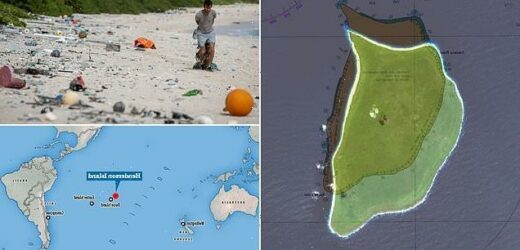Royal Navy discovers remote Henderson Island in the South Pacific declared the ‘most polluted in the world’ has been marked in the WRONG place on maps for 85 years
- Sailors on board Royal Navy vessel HMS Spey discovered the error
- Used ship’s radar and GPS satellites to obtain new images of island’s position
- It was found to be a mile south of where it features in charts drawn up in 1937
The Royal Navy has discovered a remote Pacific island has been marked in the ‘wrong place’ for 85 years.
British sailors now say Henderson Island – which is one of the Pitcairn Islands – is a mile south of the position shown in charts that have been used by mariners all over the world since 1937.
Yesterday evening Royal Navy patrol ship HMS Spey confirmed the error as part of efforts to check and update charts of waters around British Overseas Territories that are scattered around the globe.
The sailors used Spey’s radar and GPS satellites to obtain new images of the island’s exact position.
When these were overlaid on the existing charts, the island was found to be in the wrong place.
Henderson Island has earnt its unfortunate moniker of the ‘most polluted in the world due to the masses of man-made debris that have been dumped on its shoreline by Pacific currents.
It has been estimated that 270 objects every day wash up on its beaches – with as many as 40 million items of plastic and rubbish scarring Henderson’s landscape.
The South Pacific island, uninhabited and about the size of Oxford, is one of four in the remote Pitcairn chain. All are British Overseas Territories.
The Pitcairns were made famous following the 1789 Mutiny on the Bounty, when Captain William Bligh was ousted by his second-in-command, Fletcher Christian.
The current islanders, who are just 47 in number, are descendants of the sailors who took part in the mutiny.
The Royal Navy has discovered a remote Pacific island has been marked in the ‘wrong place’ for 85 years. British sailors now say Henderson Island is one mile south of the position shown in charts that have been used by mariners all over the world since 1937. Above: The old and new position
Henderson Island has earnt its unfortunate moniker of the ‘most polluted in the world due to the masses of man-made debris that have been dumped on its shoreline by Pacific currents
Chile lies 3,600 miles to Henderson’s east and New Zealand 3,200 miles to its southwest.
The Royal Navy has been using navigational charts supplied by the UK Hydrographic Office for more than 225 years and over the past 15 years, the majority of the fleet has been navigating with digital charts.
According to the Navy, key areas and seas regularly used are well covered by the electronic system – which not only ensures navigational accuracy, but allows sailors to ‘interrogate’ key features such as landmarks, buoys and depths.
However, the Pitcairn chain’s position on the electronic system needed updating, after only being the subject of some satellite-based data collection which already revealed inaccurate positioning on historical charts.
HMS Spey’s captain then offered to assist with new data gathering.
The South Pacific island, uninhabited and about the size of Oxford, is one of four in the remote Pitcairn chain, which are all British Overseas Territories
Yesterday evening Royal Navy patrol ship HMS Spey (pictured, with Royal Navy sailor in the foreground) confirmed the error as part of efforts to check and update charts of waters around British Overseas Territories that are scattered around the globe
Henderson Island’s true position is seen plotted above after the Royal Navy’s exploration work
She is not a dedicated survey vessel, but navigator Lieutenant Michael Royle used radar imagery gathered by Spey’s sensors and GPS positioning and then overlaid the details on the existing charts of the Pitcairn chain.
‘In theory, the image returned by the radar should sit exactly over the charted feature – in this case, Henderson Island,’ Lieutenant Royle explained.
‘I found that wasn’t the case – the radar overlay was a mile away from the island, which means that the island was plotted in the incorrect position when the chart was first produced.
‘The notes on the chart say that it was produced in 1937 from aerial photography, which implies that the aircraft which took the photos was slightly off in its navigational calculations.’
Navigator Lieutenant Michael Royle (pictured) used radar imagery gathered by Spey’s sensors and GPS positioning and then overlaid the details on the existing charts of the Pitcairn chain
The work by Spey is part of much wider government programme to update maritime charts of waters around the UK’s overseas territories
Henderson Island was last visited by the Royal Navy in late 2018 when HMS Montrose conducted an environmental survey to study the impact of plastics in the oceans. Above: Plastic waste is seen on the island’s beach
The work by Spey is part of much wider government programme to update maritime charts of waters around the UK’s overseas territories and improve navigation using sonar, airborne laser techniques and satellites to better understand, manage and protect the marine estates of these territories.
Henderson Island was last visited by the Royal Navy in late 2018 when HMS Montrose conducted an environmental survey to study the impact of plastics in the oceans.
‘Scientists in the UK have really scant data about the ocean in this region – its salinity, temperature, water pressure and the like,’ Lieutenant Royle added.
‘They are keen to understand climate change in the area.’
The ship also conducted patrols in the waters around the islands to deter and defend against illegal fishing, in partnership with the UK’s satellite monitoring programme run by the Marine Management Organisation.
Portsmouth-based HMS Spey is on a five-year mission to the Indo-Pacific region with her sister HMS Tamar.
The latter ship was recently used to help the people of Tonga in the wake of the recent tsunami.
MUTINY IN PARADISE: PITCAIRN’S ANCESTORS WASHED UP ON THE HMS BOUNTY IN 1790 AFTER CASTING THEIR CAPTAIN ADRIFT IN A DINGHY
The Mutiny on the Bounty took place in 1789 when Captain William Bligh was ousted by his second-in-command, Fletcher Christian.
Bligh was cast adrift in a dinghy and later landed on the island of Timor, in the then Dutch East Indies, from where he travelled back to Britain.
The mutineers first sailed to Tahiti, dropping off 16 of their number.
Fletcher Christian, eight mutineers and 18 Tahitians – six men and 12 women – then set sail to avoid apprehension, landing on Pitcairn in 1790.
The Mutiny on the Bounty took place in 1789 when Captain William Bligh was ousted by his second-in-command, Fletcher Christian
The Tahiti-based mutineers were recaptured in 1791. Three were later executed after a trial.
In 1793, the mutineers and the male Tahitians fought a war, that killed all the male Tahitians and four of the mutineers, including Christian.
By the time a U.S. ship visited in 1808, only one mutineer, John Adams, was still alive, with nine women and some children.
The population has dropped from 250 in the 1930s to 50.
Source: Read Full Article











